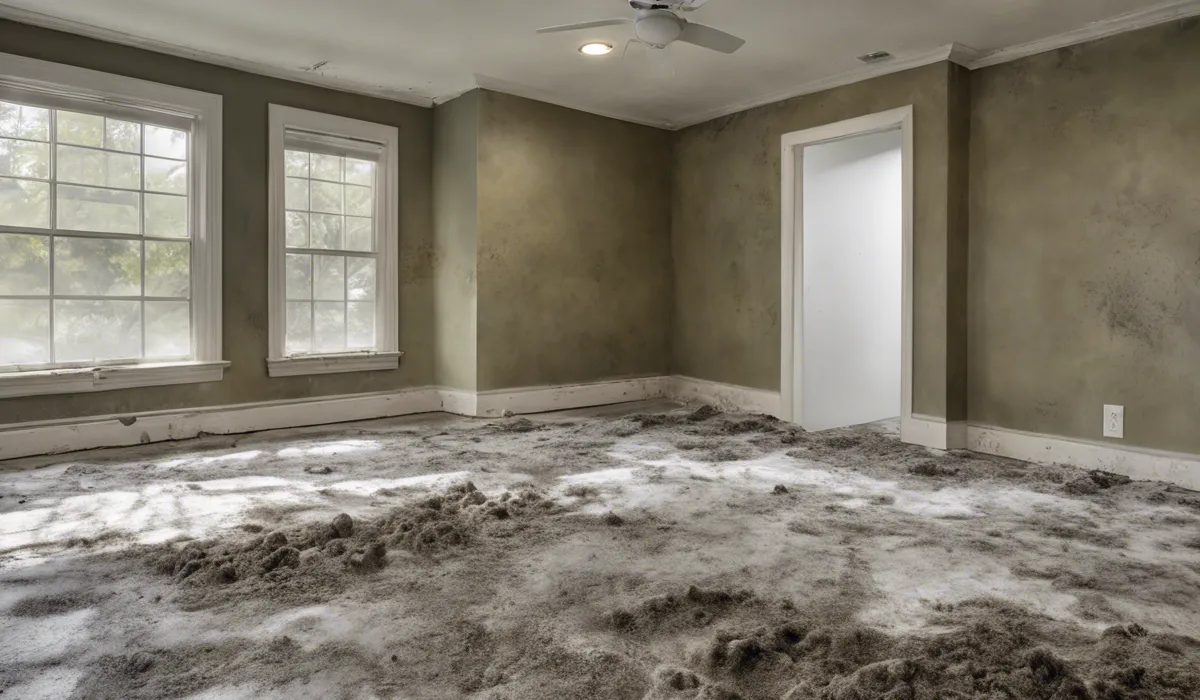Professionals use EPA-approved fungicides and antimicrobial agents to kill mold. They may also employ HEPA vacuuming and advanced cleaning techniques like media blasting or dry ice blasting for mold remediation.
Understanding Mold and Its Dangers

What Is Mold?
Mold is a type of fungus that can grow both indoors and outdoors, thriving in damp, warm, and humid environments.
Spores, which are tiny, lightweight particles, allow mold to spread and colonize new areas when they find the right conditions.
These spores are present in the air we breathe, making it impossible to eliminate them entirely.
Nonetheless, when they land on surfaces that provide adequate moisture and nutrients, such as wood, paper, or fabric, they can grow into visible colonies.
Health Risks of Mold Exposure
Exposure to mold can lead to a variety of health issues, particularly for individuals with allergies, asthma, or compromised immune systems.
Some common symptoms include coughing, sneezing, throat irritation, nasal stuffiness, and skin rashes. In more severe cases, mold exposure can lead to serious respiratory problems.
The Growth Cycle of Mold
Mold begins its life cycle as a spore, which lands on a suitable surface and starts to grow into a colony by producing hyphae.
These hyphae extend outwards and release enzymes to break down and absorb the material they are growing on, which can lead to structural damage in buildings.
Importance of Professional Mold Remediation
Due to the potential dangers and the difficulty in effectively removing mold, it is critical to engage professional remediation services.
Professionals have the expertise and equipment to safely and thoroughly remove mold infestations, ensuring that indoor environments are safe for occupants.
Professional Mold Remediation Techniques

Mold Assessment and Inspection
Before any mold remediation work begins, professionals conduct a detailed assessment and inspection to identify the extent of the mold problem.
They use tools like moisture meters and thermal cameras to locate the source of moisture and the spread of mold throughout the property.
Containment and Safety Measures
To prevent the spread of mold spores during remediation, professionals set up containment barriers using plastic sheeting and negative air pressure.
They also follow strict safety protocols, wearing personal protective equipment to safeguard their health.
Mold Removal Methods
Once containment is in place, professionals use various methods to remove mold. HEPA vacuuming captures even the smallest spores, while antimicrobial agents kill mold at the source.
In some cases, more aggressive techniques like media blasting may be necessary.
Dehumidification and Drying
Structural drying and dehumidification are crucial steps in mold remediation, as they remove the moisture that allows mold to grow. Professionals use industrial-grade dehumidifiers and air movers to ensure the affected areas are completely dry.
Tools and Products Used by Professionals to Kill Mold

Personal Protective Equipment
Professionals always wear appropriate PPE, including gloves, goggles, and respirators, to protect themselves from mold spores and the chemicals used during remediation.
HEPA Filters and Vacuums
HEPA filters are essential in trapping mold spores that are as small as 0.3 microns in diameter.
Professionals use HEPA vacuums during and after remediation to ensure that all spores are removed from the environment.
Chemical Agents
EPA-approved biocides, disinfectants, and fungicides are used by professionals to kill mold on various surfaces. These chemicals are applied carefully to avoid any potential health risks to occupants.
Advanced Technologies
Technologies like ultraviolet light and ozone generators are sometimes used to kill mold at the molecular level.
Thermal cameras are also utilized to detect hidden moisture that could contribute to mold growth.
FAQs About Mold Remediation Techniques
What chemicals do professionals use to kill mold?
Professionals use EPA-approved fungicides and antimicrobial agents specifically designed to kill mold.
Do professionals use vacuuming for mold remediation?
Yes, professionals often employ HEPA vacuuming as part of the mold remediation process to capture mold spores.
What advanced cleaning techniques are used for mold remediation?
Media blasting or dry ice blasting are advanced cleaning techniques that professionals might use to remove mold.
Is media blasting effective for mold removal?
Yes, media blasting is an effective method for removing mold from surfaces, especially from wood and other porous materials.
Can dry ice blasting kill mold?
Dry ice blasting can effectively kill and remove mold by freezing and lifting the mold from the affected surfaces.
Final Thoughts
Professionals combat mold through the application of EPA-approved fungicides and antimicrobial treatments.
These specialized substances are effective in mold eradication. In addition, techniques such as HEPA vacuuming and advanced cleaning methods, including media and dry ice blasting, are utilized for comprehensive mold remediation, ensuring thorough removal and prevention of mold recurrence.
